Spectrum: Autism Research News
The lost girls
Misdiagnosed, misunderstood or missed altogether, many women with autism struggle to get the help they need.
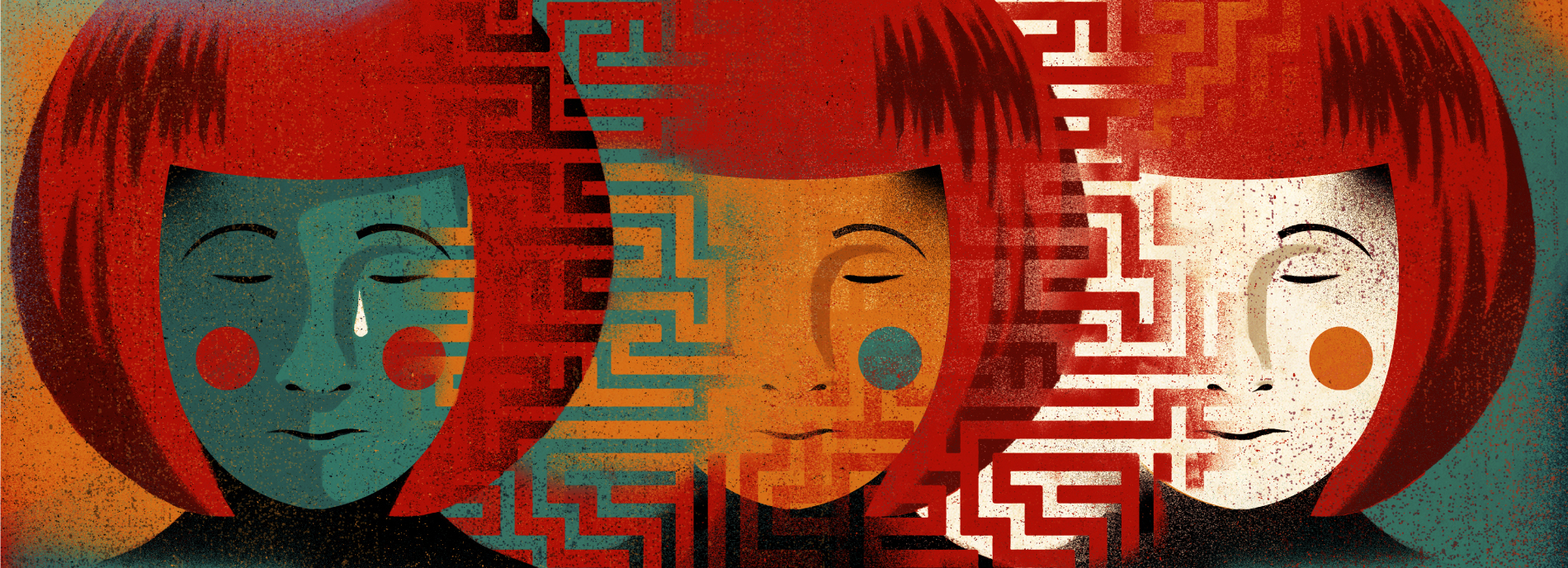
It took 10 years, 14 psychiatrists, 17 medications and 9 diagnoses before someone finally realized that what Maya has is autism. Maya loves numbers, and with her impeccable memory, she can rattle off these stats: that the very first psychiatrist she saw later lost his right to practice because he slept with his patients. That psychiatrist No. 12 met with her for all of seven minutes and sent her out with no answers. That during her second year at Cambridge University in the U.K., industrial doses of the antipsychotic quetiapine led her to pack on more than 40 pounds and sleep 17 hours a day. (Maya requested that her last name not be used.)
But those numbers don’t do justice to her story. It’s the long list of diagnoses Maya collected before she was 21, from borderline personality disorder to agoraphobia to obsessive-compulsive disorder, that begin to hint at how little we understand autism in women.
Her conversation with psychiatrist No. 14 went something like this:
Do you hear things that others don’t?
Yes. (Maya’s hearing is excellent.)
Do you think others are talking about you behind your back?
Yes. (Maya’s extended family is particularly gossipy.)
The psychiatrist didn’t explain exactly what he was trying to assess. Literal to a fault, Maya didn’t explain what she meant by her answers. She left his office with her eighth diagnosis: paranoid personality disorder.
Maya does have some of the conditions she’s been diagnosed with over the years — she’s been depressed since the age of 11, has crippling social anxiety, and in her teens, wrestled with anorexia. But these were just expressions of the autism that was there for anyone to see had they looked closer. “It’s all secondary to the Asperger’s,” says Maya, now 24. “I get depressed and anxious because life is difficult; it’s not the other way around.”
It’s not uncommon for young women like Maya to be repeatedly misdiagnosed. Because autism is at least three times as common in boys as in girls, scientists routinely include only boys in their research. The result is that we know shockingly little about whether and how autism might be different in girls and boys. What we do know is grim: On average, girls who have mild symptoms of autism are diagnosed two years later than boys. There’s some debate about why this might be so. From the start, girls’ restricted interests seem more socially acceptable — dolls or books, perhaps, rather than train schedules — and may go unnoticed. But the fact that diagnostic tests are based on observations of boys with autism almost certainly contributes to errors and delays.
As they enter their teens, girls struggle to keep up with the elaborate rules of social relationships. Cribbing style notes on what to say and how to say it, many try to blend in, but at great cost to their inner selves. Starting in adolescence, they have high rates of depression and anxiety — 34 and 36 percent, respectively. A few studies have also found an intriguing overlap between autism and eating disorders such as anorexia, although the studies are too small to estimate how many women have both.
Even after a girl gets the right diagnosis, she may be offered behavioral therapy and specialized lesson plans, but they’re essentially the same services offered to a boy in the same situation. Scientists and service providers rarely acknowledge the additional challenges being female may bring, whether physical, psychological or societal. There are no guidebooks for these girls or their families about how to deal with puberty and menstruation, how to navigate the dizzying array of rules in female friendships, how to talk about romance and sexuality or even just stay safe from sexual predators. Advocates and scientists in other disciplines have run up against and resolved many of these same problems, but in autism, the fact that boys and girls are different is sometimes treated as if it’s a startling new discovery.
In the past two to three years, there has been an uptick in the attention paid to the issues that affect women with autism. More money is now available for scientists to study whether and how autism differs in boys and girls. This past year, the journal Molecular Autism dedicated two special issues to research specifically exploring the influence of sex and gender on autism. “Almost overnight, we went from a couple of people talking about sex differences to everyone studying this as a major factor in the field,” says Kevin Pelphrey, Harris Professor at the Yale Child Study Center.
Unpublished results from Pelphrey’s lab confirm what common sense suggests: Women with autism are fundamentally different from men with autism. Autism’s core deficits may be the same for both, but when the symptoms intersect with gender, the lived experience of a woman with autism can be dramatically different from that of a man with the same condition.
“You can see by meeting with me that I’m quite chatty and that people wouldn’t guess that I have Asperger’s."
Girl power:
From its first clear description in 1943 by Leo Kanner, autism has been known to crop up in more boys than girls. But why this is so remains a mystery.
At first, scientists looked for the simplest explanation: that a boy who carries a faulty stretch of DNA on his single X chromosome develops autism, whereas a girl who inherits the same mutation would be unaffected because she has a second X chromosome to compensate.
But the search for this X-factor went nowhere. “I think the thinking is now moving more to the idea that women are protected, which I know sounds like two sides of the same coin, but it plays out in a different way,” says Stephan J. Sanders, assistant professor of psychiatry at the University of California, San Francisco. The idea is that, for as-yet unknown reasons, women can tolerate more mutations than men can, and so need a bigger genetic hit to develop autism.
A 2012 paper that laid out this ‘female protective effect’ in autism marked a turning point in the field, bringing the topic of girls with autism into the spotlight. “Once the genetics community became interested in it, it just absolutely took off,” says Pelphrey.
Around the same time, Pelphrey and his collaborators won a five-year, $13 million grant to probe the differences between girls and boys with autism, as well as their unaffected siblings. They are recruiting 250 girls with autism between 6 and 17 years old at six sites across the U.S. They plan to characterize the behavior, genetics, and brain structure and function of these girls and compare these findings with data from 125 boys who have autism, as well as from 50 children in each of the following groups: typically developing boys, typically developing girls, unaffected male siblings and unaffected female siblings of children with autism. “We’re trying to address the question: Are girls different? And how are they different?” says Pelphrey.
A few studies have explored this question. There seems to be an overall consensus among scientists that at the more severe end of the spectrum — characterized by low intelligence quotient (IQ) and repetitive behaviors — there is little outward difference between girls and boys with autism. It’s at the other end of the spectrum that the science is fuzzier. Given the small numbers of women with autism in the studies, there are few definitive answers.
“Clinically, my general impression is that young girls with autism are different [from boys], but it has been very hard to show that in any kind of a scientific way,” says Catherine Lord, director of the Center for Autism and the Developing Brain at Weill Cornell Medical College in New York City. On average, girls are more chatty, less disruptive and less likely to be entranced by trains or moving vehicles than boys are, she says. However, she adds, this is also true of typical girls and boys, so it becomes difficult to separate gender differences in autism from gender differences in general.
Early studies estimated that at the high-IQ end, the male-to-female ratio is as high as 10-to-1. The picture emerging from studies looking at girls with autism over the past few years suggests this ratio is artificially inflated, either because girls at this end of the spectrum hide their symptoms better, or because the male-biased diagnostic tests aren’t asking the questions that might pick up on autism in these girls — or both.
“For some males, you can make the diagnosis at least provisionally in your mind within 10 minutes of them coming into your office,” says Simon Baron-Cohen, director of the Autism Research Center at Cambridge University in the U.K. “Whereas for some of the women, it might take half an hour or not till halfway through a three-hour diagnostic interview before they’re revealing what’s behind the mask.”
Hidden hurt:
It takes hours to see glimpses of the pain Maya has endured over the years. She makes eye contact, pokes fun at herself and takes turns in conversation — things people with autism are generally known to have trouble doing. On a warm June day in London, dressed casually in a T-shirt and shorts, she looks like any other British 20-something. “You can see by meeting with me that I’m quite chatty and that people wouldn’t guess that I have Asperger’s,” she says.
Maya is proud of her accomplishments — and rightfully so. She excelled at school: She could read fluently by age 5 and began reading four or five books a week. She was lead violinist at her school, performing at the Barbican Centre in London, and can also play piano and viola. She taught herself to play the clarinet, and after 9 months of lessons, performed a Mozart concerto at her school.
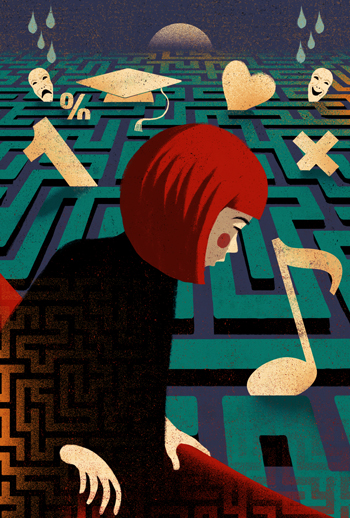 But as the conversation turns more intimate, she and her mother reveal the agony that has formed the backdrop to her achievements. At 4, Maya had severe separation anxiety and screamed every time strangers entered her nursery school. Later, at her all-girls school, she sat by herself at playtime, and read everywhere, even on stage at a cousin’s raucous wedding. She struggled with small talk, regularly made social faux pas — blurting out the denouement of a mystery, or reciting divorce statistics at an engagement party — and rambled on about her interests so long that her mother devised a secret gesture, a tap on the watch, to signal her to stop.
But as the conversation turns more intimate, she and her mother reveal the agony that has formed the backdrop to her achievements. At 4, Maya had severe separation anxiety and screamed every time strangers entered her nursery school. Later, at her all-girls school, she sat by herself at playtime, and read everywhere, even on stage at a cousin’s raucous wedding. She struggled with small talk, regularly made social faux pas — blurting out the denouement of a mystery, or reciting divorce statistics at an engagement party — and rambled on about her interests so long that her mother devised a secret gesture, a tap on the watch, to signal her to stop.
Any small disruption in her routine — dinner on the table 10 minutes later than promised, a late appointment, her little brother sitting in her favorite chair — could ruin her week. (“It’s not something I like about myself,” Maya says. “I can’t help having this need for wanting everything to be the same — but I do.”) She rarely got a good night’s sleep and had debilitating nightmares. She turned down invitations to ‘aimless’ social activities such as shopping, and called other girls out when they flouted the school’s rules, turning would-be friends into enemies.
By the time she was 8, she was bullied so much at school that she became sick with anxiety every Sunday night. At 11, her parents finally switched schools, but she was bullied there as well — even on the 45-minute bus ride each way.
Looking for the common factor, Maya’s logical mind pinned the blame on herself rather than on the cruel social games of girlhood. “I thought: ‘Everything’s different — the school’s different, the people are different, yet the bullying is the same,’” she recalls. “Therefore, the only thing it can be is that something’s wrong with me.”
The bullying got violent and more vicious as she got older. She recalls one set of girls telling her that the world would be a better place if she weren’t in it, and that they felt really sorry for her parents. Ever honest herself, Maya believed them: “I won’t say things unless they’re true, so I thought, why would they?”
When she was about 12, Maya began secretly cutting herself. Like many girls with autism at this age, Maya was keenly aware of all the ways in which she was being excluded by her peers. She became intensely depressed, launching her long and dysfunctional relationship with the psychiatric establishment.
At 15, to keep herself occupied during the unstructured summer holidays, Maya began volunteering with boys who have autism — at first only because the organization was around the corner. She never made the connection that she might have something in common with them. She brought one of the young boys home to visit once, and still neither her father, a physician, nor her mother, a clinical virologist, picked up on any similarities.
“My picture of autistic was what this little boy was like — and that’s not what Maya’s like. He was nonverbal, disruptive,” her mother, Jennifer, says. “I would not have made the connection with all the unhappiness she experiences.”
The bullying stopped at 16 when Maya was moved into a new class at the school. But soon after, she became obsessed with controlling her weight. Like many other adolescent girls with autism, she developed an eating disorder. The way she sees it now, that preoccupation was an outgrowth of another aspect of her autism — her love of numbers. “I was obsessed with decreasing the number of calories I ingested, and the numbers on the scale going down,” she says. Anorexia also resonated with her perfectionistic streak. “It’s fine if it’s something like learning musical instruments,” she says. “It’s not so fine if you decide to starve yourself, because I wanted to do that to perfection as well.”
Over the next two years, Maya became “a master of disguise,” hiding her food and exercising in secret, even on a family safari in Kenya in July 2009. “You know what I remember about that trip? I remember that I gained 400 grams in two weeks; that’s what I remember,” Maya says.
Each accomplished target led to the next until at one point Maya, who is 5 feet 6.5 inches, weighed just under 44 kilos (about 97 pounds). “The anorexia has been, from my perspective, possibly the most difficult thing to cope with, out of all the things we have gone through,” says her mother Jennifer.
In August 2009, relenting to her parents’ pleas, Maya went back to her first psychiatrist. She emerged with six diagnoses, including anorexia, generalized anxiety, bipolar disorder and agoraphobia.
In October of that year, despite the ongoing anorexia, Maya’s parents drove her to Cambridge University, her life’s dream until that point, crying all the way home because they were so worried about her. At first, Maya seemed to thrive — she enjoyed her classes, and made friends who were “quirky” like her, her mother says. But soon, she stopped talking about her new friends, and when her friends would knock on her door, she simply wouldn’t answer. The depression that had come and gone since she was 11 resurfaced. “I didn’t want to socialize, I didn’t want to see anyone, it was too difficult,” Maya says. She also began taking overdoses of her meds, enough to get her on the radar of the local mental health team.
Maya’s second year was the same. She continued to struggle with anorexia: “It clocked that my goal was to weigh nothing.” Then one day, her counselor at Cambridge pointed out that even if she had no fat or muscle, she would still carry the weight of her bones. “Therefore, I could never weigh nothing, even if I was dead,” Maya recalls thinking. As is the case for many people with autism, facts hold great power for Maya. The logic of the counselor’s statement got through to her like no amount of pleading from her parents had. “I realized that what I was doing was completely pointless. I was never going to get where I wanted to.”
The relief from the decision to stop controlling her weight carried Maya through her second year. The family once again went on an exotic holiday, this time to the Galapagos, and Maya seemed at peace. She swam with the dolphins — and she ate.
But back at Cambridge for her final year, she again sank into a deep depression. Her mother, who had rented an apartment in town and slept on Maya’s floor one or two nights a week, urged her to leave university so she could focus on feeling better. Quitting went completely against the grain for Maya. “I don’t give up on things,” she says. “I hate it when plans change. My plan was to finish school, go to university, graduate. My plan was not to get so depressed that I had to leave university.” But four weeks into the term, after getting no help from a university psychiatrist (the one who allotted her seven minutes), she made the difficult decision to leave.
Far from making her feel better, however, leaving Cambridge made her feel as if she had no future. Overweight and sluggish, she slept through her days at her parents’ house. On the 29th of December, after going out to lunch (which Maya finds stressful), cooking her family dinner (which she loves to do), and a pleasant and unremarkable night of watching television with them, Maya took more than 30 tablets of paracetamol (acetaminophen), about 15 codeine pills and all the quetiapine she could lay her hands on.
“Nothing was getting better,” she says. “I just gave up; I’d had enough of life.”
A short while after taking the pills, Maya panicked that she was still awake, and that she might begin to vomit, something she dreads. She woke her parents and, within a half hour of arriving at the emergency room, fell into a coma.
Social networks:
Social isolation, bullying and depression are not exclusive to girls with autism — boys experience them too. But for older girls with autism, the intricacies of their social world add layers of complexity.
In early childhood, boys and girls with autism are about the same. If anything, girls appear to be more social — whether because they actually are or are just perceived to be. As they edge closer to adolescence, however, girls with autism lose this early social advantage, becoming less and less likely to have friends, and more likely to be isolated. “It can be very, very tough for them,” says Pelphrey.
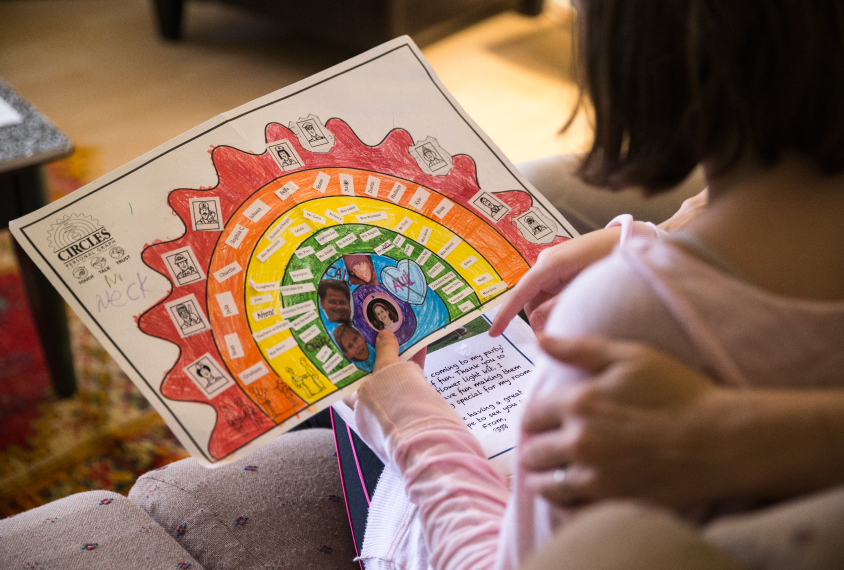
Rainbow chart: A color-coded guide can help girls with autism know whom they can hug and who just gets a wave.
Photographs by Cristina Pye
For some girls, that may be a result of having mostly been in classes with boys who have autism. But even for girls who are placed in mainstream schools, the rituals of female adolescence can be boring or bewildering.
Adolescent boys tend to socialize in loosely organized groups focused on sports or video games, allowing a boy with minimal social skills to slide by, says Kathy Koenig, associate research scientist at the Yale Child Study Center. “For girls, socialization is all about communication, all about social-emotional relationships — discussions about friendship, who likes who and who doesn’t like who and who is feuding with who,” Koenig says. “Girls on the spectrum don’t get it.”
Adolescence can be a confusing time for any young girl, but for a girl with autism, “trying to make friends and not understanding why the friendships aren’t lasting, or why you’re not being included when people are making plans” can be incredibly isolating, says Baron-Cohen. “You’re aware enough to know that you’re failing, basically.”
Ostracized and aware of it, adolescent girls with autism become highly anxious and depressed, and many develop eating disorders. This trend remains constant until late middle age, when clinicians suspect that, as they are known to do in the general population, the differences in mood disorders between men and women with autism may even out.
There are any number of programs for people with autism that teach specific behavioral skills — improving eye contact or turning your body toward the person you’re speaking to, for example. But there is almost nothing to give adolescent girls the kind of emotional support that only comes from true companionship.
In the U.S., there seem to be just three such programs — one at Yale, one at the University of Kansas, and a new center in New York City.
The Yale program, which Koenig launched more than three years ago, brings girls with autism together for yoga, or to make jewelry or to watch the blockbuster movie “Frozen”— the same kinds of activities typical girls might do. There are different groups for young girls, teenagers and young women, with about 102 families registered in total. Some groups are purely social, but others offer training for interviews, or provide support for women in college.
The Kansas program, called Girls’ Night Out, goes one step further by pairing typical girls and girls with autism. Groups of girls might visit a hair or nail salon, a coffee shop or gym, or learn how to buy clothes appropriate for their age and the weather.
“I was worried at the beginning that people would think I was trying to change them, that I was focusing on appearance,” says program director Rene Jamison, clinical associate professor at the University of Kansas in Kansas City. But hearing from parents and from the girls themselves what a difference it has made to their confidence levels has been reinforcement enough, Jamison says.
Learning to brush their own hair or teeth and to use deodorant can make all the difference to teenage girls in social situations, Jamison says. “These are skills that other girls are picking up on naturally, and getting better at,” she says. “That’s not happening naturally for some of the girls we work with, and so, just like social skills, it has to be an explicitly taught thing sometimes.”
Growing up:
Even with early diagnosis, with social skill and behavioral training and numerous other avenues of help, girls with autism and their families have little help coping with a key milestone: puberty.
Isabel Haldane, or ‘Lula,’ as everyone calls her, is 11, and for most of her life has had multiple experts dedicated to helping her navigate the world, beginning with her anthropologist parents. Until she was about 15 months old, Lula seemed precocious, walking early and rapidly picking up words. Sometime between 15 and 18 months, she lost her words and began humming — the closest approximation of the sound, her mother says, is in the movie “Finding Nemo” when the character Dory is trying to imitate a humpback whale — during the day, and wailing in frustration all night. She also didn’t make eye contact or respond to her name, so by age 2, she was diagnosed with autism and recruited into an early intervention program.
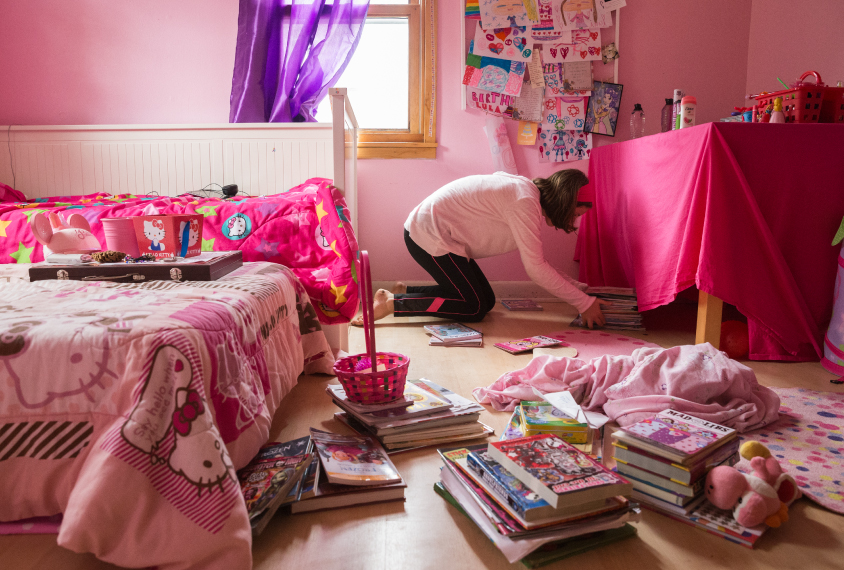
Kaleidoscope: As she rearranges her room, Lula Haldane frets about getting older.
Since then, Lula has had combinations of speech therapy, playtime therapy, pivotal response therapy — a form of applied behavioral analysis, the most common autism treatment — occupational therapy and social skills training. Starting at age 3, she placed into her local public school in suburban Connecticut, where she spends 11 months of the year, but she still has therapists who work with her for about five hours a week at school, and another hour a week at home.
Thanks to all this help, by age 5, Lula was mostly toilet trained and began to talk. By 9, she began sleeping through the night, and her parents could finally stop taking turns staying up with her all night. She scores below average on traditional IQ tests, but like many children with autism, she is adept at some things and stumped by others. She can shower, dress herself, pack her bag and wait for the school bus at the bottom of her parents’ driveway, but she might do it all at 5 a.m., hours before she’s supposed to. She can decode any word — ‘catastrophe,’ for example, or ‘encyclopedia’ — but ask her what the word means and she might respond with “I love Scott Walker” (a classmate, not his real name).
Many of the school’s students have known Lula since she was 5. But while the other girls have moved on to dance and gymnastics and music recitals, Lula is still mostly fixated on Hello Kitty. As kind as the girls are to Lula, they see themselves more as her protectors than as her friend.
Lula feels any social rejection acutely. She has memorized the birthdays of all of her friends but knows she is only invited to two parties a year. On a recent afternoon, as she arranged and rearranged her Hello Kitty-themed room, she perseverated about not seeing her friends at camp and about not wanting to get older.
Lula’s periods began just before she was 10, and she is fully developed physically, a beautiful brown-haired girl who looks older than her years. Puberty has brought enormous unforeseen challenges. Although Lula has learned how to use sanitary pads and sometimes remembers to change them, she doesn’t always think to dispose of them properly. “I didn’t even realize how much instruction it took to deal with a monthly occurrence. I didn’t know where to go on the Internet or who to ask,” says Hillary Haldane, Lula’s mother. “Where is the tutorial on this?”
Lula also shows a preteen’s healthy curiosity in sex, but none of the embarrassment or hesitation that might typically accompany it. A boy at school Lula has taken a shine to comes up in conversation often. She might announce that she wants to touch his penis, or smell his crotch. When she has blurted out these comments in school, her teachers’ reaction has been to isolate her. Knowing it goads the adults around her, Lula has taken to doing it even more.
“As we go into middle school, this is the biggest fear I have: her saying these things and then being ridiculed or bullied for it,” says Haldane. Even more worrying for her parents is the sort of attention she might attract outside school: “It’s so terrifying with the sexual predatory behavior that she might face, especially because her body is quite developed, and her sexual curiosity, and how much more I have to consider what her behavior signals to others as opposed to if she was a boy on the spectrum.”
Deeper worries:
Safety is an enormous concern for women who cannot advocate for themselves, and it weighs heavily on families’ minds. For Karleen, whose daughter Leigh, 28, is a nonverbal woman with autism, fighting for her daughter’s dignity has become nearly a full-time occupation. (Karleen asked that her and Leigh’s last names not be included, to protect Leigh’s privacy.)
Leigh uses a few words but, for the most part, cannot follow commands or speak. The youngest of three siblings, Leigh, like Lula, lost speech at 15 months and was diagnosed at 2. But she is unable to care for herself at all, and because of her tendency to hurt herself and others, needs around-the-clock care. “When she’s anxious, Leigh can strip right down. She can be trapped that way buck naked, until she can get the anxiety under control,” says Karleen. When she has her period, Leigh’s anxiety can skyrocket so much that she might shred pads into tiny pieces.
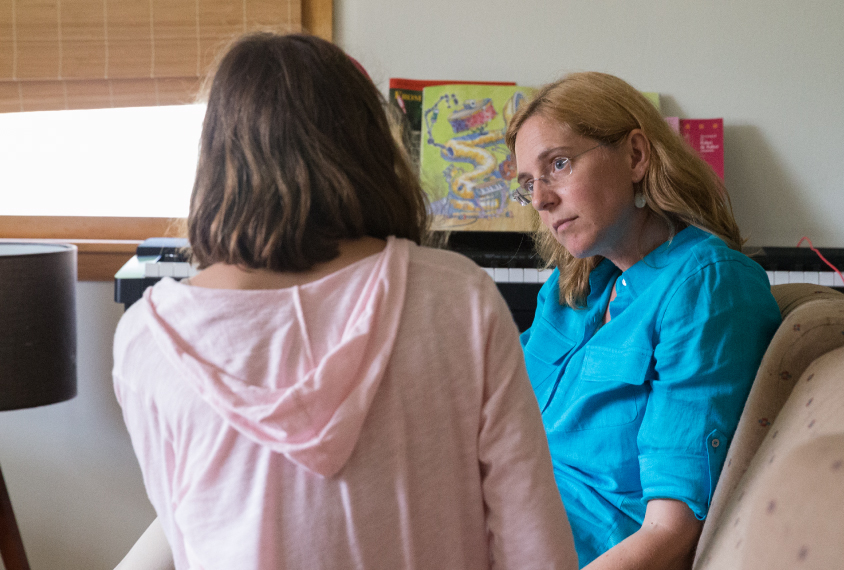
Serious concern: Like many parents of girls with autism, Hillary Haldane worries about her daughter’s safety.
After years of searching, Leigh’s family, based in Belmont, Ontario, found her a residential program that created the kind of calm and routine that Leigh needs. But the agency must follow union guidelines on equal employment, meaning that it might pair Leigh up with a male attendant.
For the past two years, Karleen has been appealing to officials at every level of the agency to allow only female attendants to work with her daughter — to no avail. In fact, she says, the agency may have to refer Leigh elsewhere because it cannot afford the legal fees to explore whether the law would allow it to only hire female attendants.
A former public health nurse who worked in women’s shelters, Karleen is only too aware of the potential for abuse, particularly with male attendants. “I think this could be a huge issue in the future,” Karleen says. The equal employment opportunity law was meant to protect people’s rights, Karleen says, but is paradoxically harming women like Leigh who need support and cannot advocate for themselves. “If you are able-bodied and you can speak or you can gather support, then you can challenge that or work that legislation on your own behalf, but if you’re someone like Leigh, then how can you be protected?”
Different worlds:
Whether it is Leigh’s thorny legal situation, Lula adjusting to her budding sexuality or Maya’s run-ins with psychiatrists who misunderstood her pain, the issues that dog women with autism have everything to do with their gender. For the first time, scientists are beginning to incorporate what they know about typical girls and their social world to understand girls with autism.
For example, it’s been known for decades that boys’ and girls’ social worlds are starkly divergent and that they learn the rules to function in these worlds in disparate ways. “There’s really good data to show that in typical girls and boys, the socialization trajectory is different,” says Koenig. “People never took that into account when they’re studying autism.”
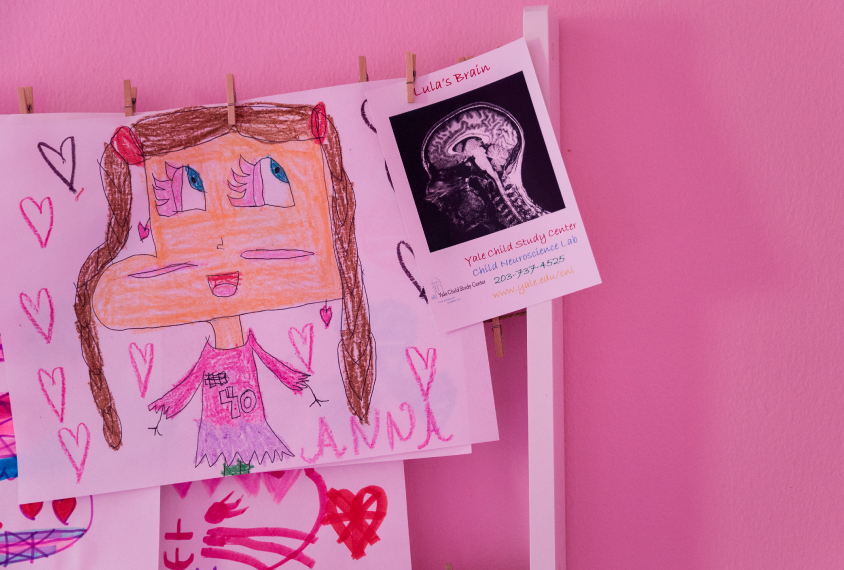
Girl brain: There are intriguing hints that in girls with autism, the social brain works differently than it does in boys with the condition.
The multisite project that Pelphrey leads is making headway into learning how girls with autism are different — both by recording their behavior and by scanning their brains. For example, one of the cardinal observations about autism is that people with the condition seem uninterested in, or at least disengaged from, social interactions. Intriguing brain imaging evidence from Pelphrey’s lab suggests that this is true only for boys with autism.
“The most surprising thing — it might not be surprising to the clinicians out there, but to the scientists — is that we’re seeing strong social brain activation or function in girls with autism, which is, strictly speaking, counter to everything we’ve reported ourselves and other groups have reported,” says Pelphrey. “Their social brains seem to be intact.”
The social brain is an interconnected set of brain regions, including the face processing fusiform gyrus; the amygdala, an emotion hub; and the superior temporal sulcus, which tracks other people’s attention and movements. Imaging studies have reported that the social brain is underactive in people with autism, but Pelphrey’s lab has found that if typical girls have the most active social brains and boys with autism the least active, typical boys would tie with girls who have autism somewhere in the middle. “That kind of blew us away,” he says.
Particularly interesting is the unpublished observation that in girls with autism, the social brain seems to communicate with the prefrontal cortex, a brain region that normally engages in reason and planning, and is known to burn through energy. It may be that women with autism keep their social brain engaged, but mediate it through the prefrontal cortex — in a sense, intellectualizing social interactions that would be intuitive for other women.
“That suggests compensation,” Pelphrey says. It also jibes with women like Maya saying they have learned the rules of social interactions, but find it draining to act on them all day. “It’s exhausting because it’s like you’re doing math all day,” Pelphrey says.
Pelphrey is right that this finding isn’t entirely a surprise to clinicians. Some scientists who regularly see women with autism have picked up on their remarkable ability to learn the rules enough to camouflage their symptoms — the way Maya has learned to. (“I don’t like making eye contact,” Maya says. “I do it because I have to and I know it’s appropriate.”)
This means clinicians have to be more creative when diagnosing women on the spectrum, rather than simply looking for, say, repetitive behavior, as they might with men. “Without their self-report telling you how stressful it is to maintain appearances, you wouldn’t really know,” says Francesca Happé, director of the MRC Centre at King’s College London. “They have good imitation, good intonation in their language, body language — surface behavior isn’t very useful for a diagnosis, at least for a certain set of women on the spectrum.”
Overall, the concept of compensation in women with autism hasn’t been well studied, Happé says. Compensation could be cognitive — learning the rules intellectually rather than instinctively, as Pelphrey describes it — or social, such as learning to mimic others. There are also societal factors at play. “Are we more tolerant, at least in some Western societies, of a girl who is very, very quiet and socially aloof, compared to a boy? I don’t know; I suppose you could say we have higher expectations of women,” says Happé. “All of these are hypotheses and they’re only interesting if they’re testable.”
A few teams, including those led by Happé and Baron-Cohen, are trying to find ways to get behind the masks. Baron-Cohen’s group is developing what he calls a “faux pas test.” If a woman is getting by learning social rules one rule at a time, as Maya has, she’s bound to make a lot of mistakes, he says, because she’s likely to encounter a situation for which she hasn’t yet learned the rules. Happé is similarly creating tests based on real-life scenarios in which her team asks women not only why somebody said something, but also what they themselves would say next. “That really trips people up. It would require them to, on the spot, get it,” she says.
Baron-Cohen, Happé and others caution, however, that in some cases, women may have learned to cope enough that they don’t actually need a diagnosis.
“If they’re coping, do they want to think of themselves or for others to think about them in that way?” asks Happé. “Then it becomes a big ethical issue, doesn’t it?”
“Without their self-report telling you how stressful it is to maintain appearances, you wouldn’t really know."
New understanding:
In Maya’s case, learning she is on the spectrum took some getting used to. But she says she’s very glad to have an explanation now for all of the difficulties she thought were unrelated to one another.
After she came out of her coma, Maya spent a week in intensive care and nine weeks in a terrifying psychiatric unit with severely ill patients. One threw a boiling cup of tea at a nurse, and another head-butted a nurse so hard that her teeth went through her lip. In the early days, Maya deliberately burned her arm with the hot water available for making tea, and threatened to try to kill herself again as soon as she got home.
But as the weeks passed, she started to feel better. She was given an antidepressant that seemed to work for her, and she lost the weight she had gained when taking quetiapine. She met a young woman who has since become her best friend. Then, several months after she left the hospital, she got the autism diagnosis.
After her disastrous encounter with the psychiatrist who decided she has paranoid personality disorder, a doctor who had been kind to her while in the hospital offered to take Maya back as a patient. It was only when Maya began complaining about the ridiculousness of offices being closed on ‘bank holiday’ Mondays (“Weekdays are for work!”) and how overwhelming it was for her to walk down a noisy street that the psychiatrist added up the signs to arrive at the correct diagnosis.
A full 18 months after Maya came home from the hospital, she went back to Cambridge for her final year and switched her focus from genetics to psychology and cognitive neuroscience. She burst into Baron-Cohen’s office at Cambridge one day while he was in a meeting, announced that she has Asperger syndrome and asked if he would supervise her dissertation on mirror neurons and autism. He agreed. She still had bouts of depression, but her stay in the hospital taught her how and when to ask for help. “When I came out of hospital, I basically lived along the lines of ‘if it’s stressful, don’t bother doing it,’” she says. “Nothing is worth getting that depressed.”
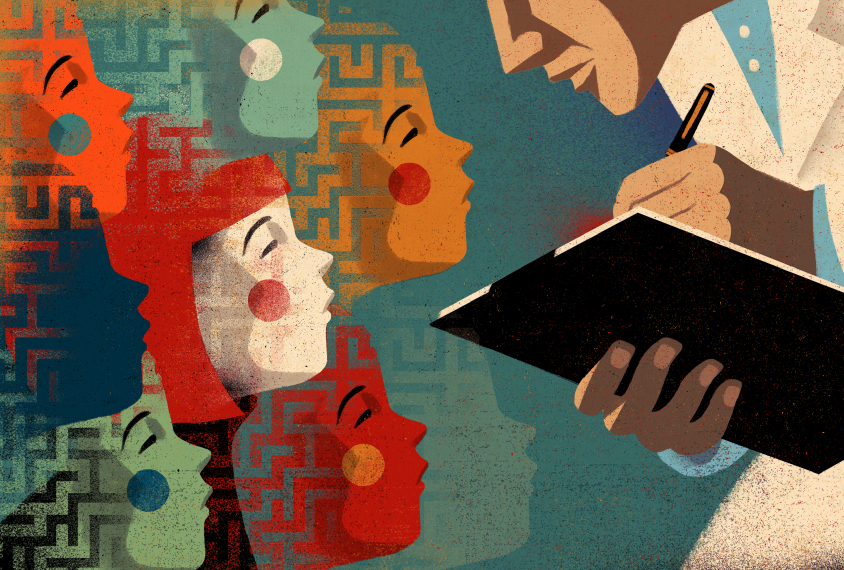
The university accommodated her diagnosis, allowing her to take her exams alone and with breaks in between, and in June 2014, despite some ongoing depression, Maya graduated from Cambridge. “If you can go in two-and-a-half years from being locked in a psych unit to graduating from Cambridge, you can do anything, really,” Maya says.
After graduation, Maya worked for a year at a local primary school, supporting boys with autism in the class. She didn’t tell the school she has autism, and successfully held down the job all year. She enjoyed it so much, in fact, that last month she began training to be a primary school teacher, specializing in mathematics, and plans to either teach mathematics or work with special needs children. And this time, Maya revealed on the application form that she has autism. “She agonized about it a lot; she didn’t want people to prejudge her,” says Jennifer.
Outside of her teacher training, Maya spends time with her best friend, even going on a holiday together “with massive success,” and has dated men on the spectrum. Most of all, she is committed to learning how to take care of herself the way only she can. One day this summer, she went on a ‘fun run’ — “which as far as I’m concerned are two words that should not be put in the same sentence,” she says — a loud and colorful obstacle course that Maya researched thoroughly online and prepared for with ear plugs. When she has a bad day, she has learned to wind down with multiple episodes of “Grey’s Anatomy,” which she has watched enough times to be able to fake being a doctor. She and her brother now laugh about her need to sit in the same seat at the dinner table, and her parents have learned to respect her need for solitude, despite their fears about what she might do when alone.
She has also been talking about her autism — at town council meetings, to groups of teachers and trainee therapists — and helping to train the staff at doctors’ offices to accommodate people with autism’s need for order and quiet.
Maya still gets depressed, still rarely has a night free of nightmares, and may still go into a tailspin if her routines are disrupted. But she is better than she was at asking for support — and often gets it from a therapist who specializes in autism whom she sees every other week, or more often if necessary.
“The more I understand myself, the more I can explain to other people what I find difficult, and the more they can help me,” she says. “Life isn’t easy for me, but I understand myself so much better now.”
Cite this article: https://doi.org/10.53053/WJAF1376
By joining the discussion, you agree to our privacy policy.